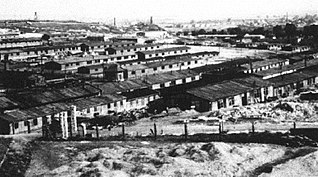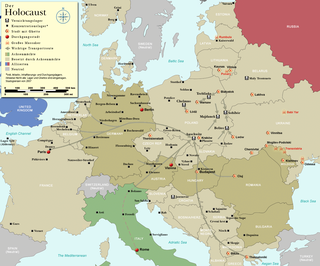
The Auschwitz concentration camp was a complex of over 40 concentration and extermination camps operated by Nazi Germany in occupied Poland during World War II and the Holocaust. It consisted of Auschwitz I, the main camp (Stammlager) in Oświęcim; Auschwitz II-Birkenau, a concentration and extermination camp built with several gas chambers; Auschwitz III-Monowitz, a labor camp created to staff a factory for the chemical conglomerate IG Farben; and dozens of subcamps. The camps became a major site of the Nazis' Final Solution to the Jewish Question.

Nazi Germany used six extermination camps, also called death camps, or killing centers, in Eastern Europe during the Holocaust in World War II to systematically murder about 2.7 million Jews during the Holocaust. Others were murdered at the death camps as well, including Romani people during the Romani genocide. The victims of death camps were primarily killed by gassing, either in permanent installations constructed for this specific purpose, or by means of gas vans. The six extermination camps were Chelmno, Belzec, Sobibor, Treblinka, Majdanek and Auschwitz-Birkenau. Auschwitz and Majdanek death camps also used extreme work under starvation conditions in order to kill their prisoners.

Majdanek was a Nazi concentration and extermination camp built and operated by the SS on the outskirts of the city of Lublin during the German occupation of Poland in World War II. It had seven gas chambers, two wooden gallows, and some 227 structures in all, placing it among the largest of Nazi-run concentration camps. Although initially purposed for forced labor rather than extermination, the camp was used to kill people on an industrial scale during Operation Reinhard, the German plan to murder all Jews within their own General Government territory of Poland. The camp, which operated from October 1, 1941, until July 22, 1944, was captured nearly intact, because the rapid advance of the Soviet Red Army during Operation Bagration prevented the SS from destroying most of its infrastructure, and the inept Deputy Camp Commandant Anton Thernes failed in his task of removing incriminating evidence of war crimes.

Mauthausen was a Nazi concentration camp on a hill above the market town of Mauthausen, Upper Austria. It was the main camp of a group with nearly 100 further subcamps located throughout Austria and southern Germany. The three Gusen concentration camps in and around the village of St Georgen/Gusen, just a few kilometres from Mauthausen, held a significant proportion of prisoners within the camp complex, at times exceeding the number of prisoners at the Mauthausen main camp.

Oświęcim is a town in the Lesser Poland province of southern Poland, situated 50 kilometres (31 mi) west of Kraków, near the confluence of the Vistula (Wisła) and Soła rivers. The town is commonly known for being the site of the Auschwitz concentration camp during World War II when Poland was occupied by Nazi Germany.

Stutthof was a Nazi concentration camp established by Nazi Germany in a secluded, marshy, and wooded area near the small town of Sztutowo 34 km (21 mi) east of the city of Danzig in the former territory of the Free City of Danzig. The camp was set up around existing structures after the invasion of Poland in World War II and initially used for the imprisonment of Polish leaders and intelligentsia. The actual barracks were built the following year by prisoners.

The German camps in occupied Poland during World War II were built by the Nazis between 1939 and 1945 throughout the territory of the Polish Republic, both in the areas annexed in 1939, and in the General Government formed by Nazi Germany in the central part of the country (see map). After the 1941 German attack on the Soviet Union, a much greater system of camps was established, including the world's only industrial extermination camps constructed specifically to carry out the "Final Solution to the Jewish Question".

Nazi Germany operated concentration camps throughout the territories it controlled before and during World War II. The first Nazi camps were erected in Germany in March 1933 immediately after Hitler became Chancellor and his Nazi Party was given control of the police by Reich Interior Minister Wilhelm Frick and Prussian Acting Interior Minister Hermann Göring. Used to hold and torture political opponents and union organizers, the camps initially held around 45,000 prisoners. In 1933–1939, before the onset of war, most prisoners consisted of German Communists and Socialists, Social Democrats, Roma, Jehovah's Witnesses, homosexuals, and persons accused of 'asocial' or socially 'deviant' behavior by the Germans.

Warsaw was a Nazi concentration camp built on the ruins of the Warsaw Ghetto, around Gęsiówka prison. A minor camp, the Warsaw camp is absent from most standard accounts of the Holocaust. Over the course of its operation an estimated 8,000–9,000 prisoners were held at the camp and performed slave labor. About 4,000 to 5,000 of the prisoners are estimated to have died in the camp, during the death march from the camp, the Warsaw Uprising, and hiding after the uprising.
The Jaworzno concentration camp was a concentration camp in WW2 German-occupied Poland and later in Communist Poland. It was first established by the Nazis in 1943 during the Second World War and was later used from 1945 to 1956 by the Soviet NKVD and then by the Ministry of Public Security and other agencies of the Polish communist regime. Today the site is an apartment complex and also houses a memorial to the camp's victims.

"Polish death camp" and "Polish concentration camp" are misnomers that have been a subject of controversy and legislation. Such terms have been used by news media and by public figures in reference to concentration camps that were built and run during World War II by Nazi Germany in German-occupied Poland.

Monowitz was a Nazi concentration camp and labor camp (Arbeitslager) run by Nazi Germany in occupied Poland from 1942–1945, during World War II and the Holocaust. For most of its existence, Monowitz was a subcamp of the Auschwitz concentration camp; from November 1943 it and other Nazi subcamps in the area were jointly known as "Auschwitz III-subcamps". In November 1944 the Germans renamed it Monowitz concentration camp, after the village of Monowice where it was built, in the annexed portion of Poland. SS Hauptsturmführer (Captain) Heinrich Schwarz was commandant from November 1943 to January 1945.

Arbeitslager is a German language word which means labor camp. Under Nazism, the German government used forced labor extensively, starting in the 1930s but most especially during World War II. Another term was Zwangsarbeitslager.

During World War II, Nazi Germany engaged in a policy of deliberate maltreatment of Soviet prisoners of war (POWs), in contrast to their treatment of British and American POWs. This policy, which amounted to deliberately starving and working to death Soviet POWs, was grounded in Nazi racial theory, which depicted Slavs as sub-humans (Untermenschen). The policy resulted in some 3.3 to 3.5 million deaths.

Wilhelm Brasse was a Polish professional photographer and a prisoner in Auschwitz during World War II. He became known as the "famous photographer of Auschwitz concentration camp." His life and work were the subject of the 2005 Polish television documentary film The Portraitist (Portrecista), which first aired in the "Proud to Present" series on the Polish TVP1 on 1 January 2006.

The Auschwitz-Birkenau State Museum is a museum on the site of the Auschwitz concentration camp in Oświęcim, Poland.

On 27 January 1945, Auschwitz concentration camp—a Nazi concentration camp where more than a million people were murdered—was liberated by the Red Army during the Vistula–Oder Offensive. Although most of the prisoners had been forced onto a death march, about 7,000 had been left behind. The Soviet soldiers attempted to help the survivors and were shocked at the scale of Nazi crimes. The date is recognized as International Holocaust Remembrance Day.

During World War II, tens of thousands of Yugoslav citizens were imprisoned in Nazi concentration camps including more than 6,000 at Mauthausen and 20,000 in Auschwitz. At least 536 Yugoslav citizens were victims of Nazi human experimentation in the concentration camps.

















